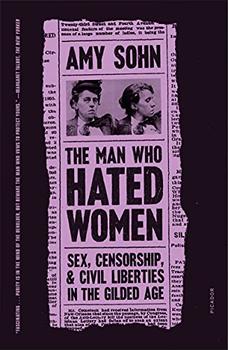Summary | Excerpt | Reviews | Beyond the Book | Readalikes | Genres & Themes | Author Bio

Critics' Opinion:
Readers' Opinion:
First Published:
Jul 2021, 400 pages
Paperback:
Jul 2022, 400 pages
 Book Reviewed by:
Book Reviewed by:
Rose Rankin
Buy This Book
The sex radicals informed and were informed by other radical movements—abolition, suffrage, Spiritualism, free love, free thought—as there was no "birth control" movement until around 1910. Angela and Ezra Heywood were abolitionists before they came to their free love ideas. Woodhull's 1872 nomination for president of the United States brought increased attention to the suffrage cause. Woodhull, Heywood, and Craddock identified as Spiritualists, claiming they could communicate with the dead. The Heywoods agitated for fair wages and civil, nonreligious marriages in their widely read journal, The Word, and at conventions of the New England Free Love League. Free thought, a broad term that encompassed secularism, freedom of religion, and freedom of speech, caught on in the 1830s, boosted by independent papers such as the Boston Investigator and New York's Free Enquirer, and by the end of the nineteenth century included groups such as the American Secular Union, of which Craddock became secretary.
At the time of their arrests for Comstock law violations, the women were as young as twenty-seven and as old as sixty-six. They were married, single, mothers, child-free, virgins, widows, and divorcées. None took reproduction lightly; one had an intellectually disabled son. Woodhull lived with present and former husbands and children; Craddock, alone; Lohman, with her adult grandchildren. Chase's husband filed for divorce on grounds of abandonment. Sanger's marriage was open, despite the wishes of her husband. Goldman, who inspired tens of thousands with her rousing speeches, was in a decade-long dysfunctional relationship with her philandering manager. Facing down Comstock, postal inspectors, and Vice Society agents, the women were unafraid and willing to be imprisoned for their cause. Nearly all were impoverished and could not afford their legal fees. The fact that several were past middle age when Comstock pursued them—and still they fought—shows their resilience.
It is no coincidence that nearly all were writers. They were products of a rich period of radical publishing, when the nationally read journals where their names appeared enjoyed wide circulation. These publications, sent by mail, included The Word; the Boston Investigator; Dr. Foote's Health Monthly; Lucifer, the Light-Bearer; Woodhull & Claflin's Weekly; The Physiologist and Family Physician; and The Truth Seeker. In papers, pamphlets, and books, the sex radicals used their pens to excoriate Comstock, the NYSSV, and the law. Nothing Comstock tried—arresting them multiple times, illegally baiting them with so-called test letters that tricked them into breaking the law, harassing them, searching their homes, menacing them in the courtroom—could deter them.
Their primary years of activism took place between the first women's rights convention in 1848 and the passage of woman suffrage in 1920, which granted white women the right to vote; many women of other races were not able to vote until the passage of the Voting Rights Act in 1965. Yet the sex radicals are not as well-known as the suffragists Susan B. Anthony, Elizabeth Cady Stanton, and Alice Paul. Many were outcasts because they were outspoken about sex. They believed in plain speech, using terms such as vagina, penis, semen, and clitoris. They arrived at their views through direct experience with rape, child marriage, alcoholic partners, and poverty, and they used autobiography to advance their political views. They made the personal political.
Though four of them were nurses or health practitioners, they lacked the medical clout of the twentieth-century sex pioneers Dr. Alfred Kinsey and Dr. William Masters. Many were self-taught or educated outside of the traditional medical colleges and societies that were founded by, and for, men. Their writing was explicit and detailed, in an era when men found libidinous women alternately terrifying or titillating, but rarely enlightening.
Excerpted from The Man Who Hated Women by Amy Sohn. Copyright © 2021 by Amy Sohn. Excerpted by permission of Farrar, Straus & Giroux. All rights reserved. No part of this excerpt may be reproduced or reprinted without permission in writing from the publisher.





The House on Biscayne Bay
by Chanel Cleeton
As death stalks a gothic mansion in Miami, the lives of two women intertwine as the past and present collide.

The Flower Sisters
by Michelle Collins Anderson
From the new Fannie Flagg of the Ozarks, a richly-woven story of family, forgiveness, and reinvention.

The Funeral Cryer by Wenyan Lu
Debut novelist Wenyan Lu brings us this witty yet profound story about one woman's midlife reawakening in contemporary rural China.
Your guide toexceptional books
BookBrowse seeks out and recommends the best in contemporary fiction and nonfiction—books that not only engage and entertain but also deepen our understanding of ourselves and the world around us.